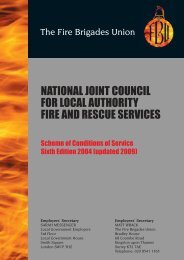Report - Fire Brigades Union
Report - Fire Brigades Union
Report - Fire Brigades Union
Create successful ePaper yourself
Turn your PDF publications into a flip-book with our unique Google optimized e-Paper software.
SECTION B — FIRE AND RESCUE SERVICE POLICY<br />
110)It is an oft-quoted comment from government that critics<br />
of the project are not comparing like with like, or using<br />
different timescales. The government appears to do this<br />
itself, making it very difficult to tie down what the full costs<br />
are or even details how the costings have changed in the<br />
various Business Cases.<br />
111)Differing language is used by government to describe<br />
various costs as “basic initial costs”, or “set up” costs to<br />
“estimated full cost of implementing FiReControl”. The<br />
Business Cases quote a figure of around £1.4billion,<br />
although that does include on-going staffing costs through<br />
the life of the project.<br />
112)These are included by government – it is their Business<br />
Case - because alleged savings were always based on<br />
cutting the numbers of emergency fire control staff. We<br />
will return to that issue later.<br />
On 22 October 2009 the following question was asked and<br />
answered:<br />
Mrs Spelman: To ask the Secretary of State for<br />
Communities and Local Government what recent estimate<br />
he has made of the total cost of delivery of the FiReControl<br />
project; and what estimates were made in (a) 2004, (b)<br />
2005, (c) 2006, (d) 2007 and (e) 2008. [293319]<br />
Mr Malik: The current estimated overall cost of delivery of<br />
the FiReControl project for (a) 2004 was £120 million; (b)<br />
2005 – £160 million; (c) 2006 – £190 million; (d) 2007 –<br />
£360 million; and (e) 2008 – £380 million.<br />
On 2 November 2009 Mr Malik answered in another<br />
question:<br />
The basic initial costs and timescales of implementing the<br />
FiReControl project, as originally estimated in 2004, were<br />
£120 million. Following more detailed work, project costs<br />
were updated to include funding to fire and rescue<br />
authorities for local and regional implementation activity,<br />
the costs of the regional control centre building leases and<br />
the costs of equipment to be installed in every fire station<br />
in England to support improved mobilisation.<br />
The expenditure to date on the project is approximately<br />
£190 million. The estimated full cost of implementing<br />
FiReControl is £420 million.<br />
113)Even on these figures the cost of the project has more<br />
than tripled.<br />
Why have costs increased?<br />
114)The reasons given in Mr Malik’s reply for some of the<br />
increased costs show how ill-thought the original estimates<br />
were. Mott MacDonald’s building costs estimates were<br />
£25.2 million and even over a ten year period (as opposed<br />
to the longer leases) are well short of the reality of the<br />
leasehold and other costs relating to the buildings.<br />
115)The fact that Station End Equipment – the ‘cost of<br />
equipment to be installed in every fire station’ – were left<br />
out of the calculations – beggars belief. It meant the<br />
project was moving along on the basis they had worked<br />
out the cost of the equipment needed to send a message,<br />
but not the fact there would need to be equipment to<br />
receive the message and it would have to be paid for.<br />
116)In a letter dated 13 November, in response to concerns<br />
raised by a constituent of Rob Marris MP, Mr Malik goes<br />
further in explaining the cost and time overruns: “the<br />
FiReControl technical solution has proved to be more<br />
complex than originally anticipated, and the development<br />
stages have taken much longer than expected.” He<br />
asserted that the contract with EADS was signed with<br />
them having a full “understanding of the technical solution<br />
required… [nor having full] information about the amount of<br />
work that would need to be carried out by the individual 46<br />
fire and rescue authorities”.<br />
117)Only once the contract had been signed – which was in<br />
2007 – he asserted, did “it become apparent that the<br />
project scope needed to be broadened”. No details of the<br />
broadening of the scope are given.<br />
118)The Outline Business Case (OBC) November 2004 sets out<br />
in some detail (at Appendix C) why the costings in the<br />
original Mott MacDonald report were wrong. The OBC<br />
identified some key areas of risks the project would face<br />
including that there was a very high risk of total project<br />
failure.<br />
119)The OBC uses a Private Developer Scheme (PDS) as its<br />
recommended method of supplying new Regional Control<br />
Centre buildings. It is an expensive option and the OBC<br />
underlines the catastrophic impact on any estimated<br />
savings of the buildings being completed more than six<br />
months before they are meant to become operational.<br />
120)The OBC heavily flagged up, as a significant risk, the<br />
financial impact of the buildings being completed more<br />
than six months before they were to start becoming<br />
operational. It also pointed out the importance of there<br />
being a degree of co-terminosity for leases for the new<br />
RCC buildings which would become the national network<br />
of regional control centres. That is they would all expire<br />
and have to be renewed at approximately the same time or<br />
within a reasonable period of each other.<br />
121)The OBC identified that from the signing of the PDS<br />
contracts to building completion would take around 18<br />
months. Building in a six month rent-free period from<br />
practical completion to becoming operational would deal<br />
with the issue of rents being paid for empty buildings and<br />
is a sensible recommendation.<br />
122)Having identified these two key traps to be avoided – and<br />
the mitigating steps needed to be taken to avoid them –<br />
the CLG project managers then walked into both traps. On<br />
10 August 2005, without any further Business Case of any<br />
kind, CLG announced it was proceeding with the PDS<br />
scheme, sites had been identified and the contracts signed<br />
with the developers for between 20 years and 25 years<br />
and which come to an end between 2027 and 2033.<br />
123)The minister, asked on 16 December in a parliamentary<br />
FBU Annual <strong>Report</strong> 2011 71

















